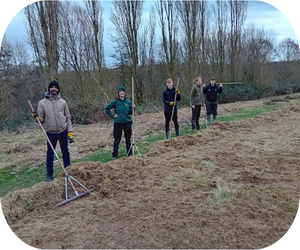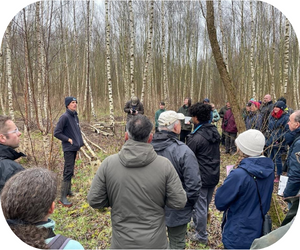Trail tales - February 2024

A monthly update from the Warwickshire Country Parks rangers
Habitat Creation Work at Ryton Pools Country Park
By Ben Coleman, Grassland Habitat Specialist Ranger
It’s been a very busy time for habitat creation at Ryton Pools Country Park this winter! One project already been completed, with one in progress and another one coming soon. We’re very grateful to our partners at the Warwickshire Wildlife Trusts Dunsmore Living Landscape team, who have provided £31, 500 in funding for these projects via Highways England’s “Networks for Nature” Scheme.
Soil inversion creates a home for sandy specialists
We have continued with a second section of our very successful soil inversion project on Pagets bank. This area of the park has historically been a stronghold for sand-loving plants which take root in the remnants of sand and gravel. Over time, however, a large increase in nutrients (possibly due to deposition of air-borne nitrogen) had led to brambles and saplings beginning to smother the area, despite efforts to keep it clear by staff and volunteers.
A re-set was needed to conserve this unique habitat, and in the winter of 2022/23, an experimental plot was excavated and inverted by machinery in the hope of burying the nutrients about one meter deep and exposing more of the nutrient poor sandy soil that the specialist plants require.

The experiment proved more successful than we anticipated, with a number of the desired species colonising rapidly. The second inversion has now been completed, with the hope that our beautiful Pyramidal Orchids and other sandy specialists will respond to the work and provide a stunning display for visitors and pollinators alike!
Boggy wetlands scraped to build biodiversity
We are now in the process of delivering a long-planned project involving a very wet area of our main recreation meadow. This area has ben very boggy in nature for a very long time and has become impossible to maintain.

Working with the land, we have now begun the creation of a marshy scrape in this area which will have a myriad benefits for our wildlife. Our hard-working volunteers helped to rake the area off and dug out some plants we wanted saving before the machines moved in. With the original vegetation scraped off, the soil has been opened up for access to forage by birds and we plan to plant the area up with native wetland plants to provide a haven for pollinators too. A fence will shortly be installed around the site and a native hedgerow planted to ensure the project supports the widest range of biodiversity possible.

The final habitat project this winter is currently at the planning stage and we will endeavour to update you on progress in a future edition of the newsletter.
We hope to monitor these sites ecologically during the next year to see how the new habitat is functioning and will be sure to keep you all posted with what turns up!
Willow Tits and Wildlife Spotlight
By James Taylor, Woodland Specialist Ranger
Surveying Willow Tit habitats

Several rangers including myself attended the Willow Tit training day at RSPB Middleton Lakes working in partnership with the Warwickshire Wildlife Trust. The day included species ecology and habitat management discussions along with call back surveys and habitat assessments. The afternoon provided an opportunity for a site visit to undertake these assessments and call back survey techniques.

We know some of our country parks have ideal habitats for Willow Tits and have had some sightings. This is great news, as Willow Tit numbers have declined sharply since the mid 1970s and the species has been red listed in the UK since 2022. This means they are of high conservation concern.
These training days provide opportunities to network with similar neighbouring organisations, and provide valuable training for our team in surveying these important species. With the funding available, we hope to increase surveying and identify the potential to manage our sites to support the preservation of this species.
Wildlife to look out for

There is still plenty of wildlife to see in country parks in February. Hazel catkins will start to appear which are monoecious, they have male and female flowers on the same plant. Redwing and Fieldfare can be spotted in the winter months feeding on the berries of hawthorn and rowan.
These birds migrate south for the winter from Scandinavia and Iceland and will fly back by the end of April. Frosty mornings give chance to spot mammal footprints on the edges off woodlands. They could be foxes, badgers, deer or rabbits. There some simple identifications tips to help such as claw marks or the number of toes they have.
Should you spot any interesting wildlife during your next park visit and would like to share your discovery with our team, please email parks@warwickshire.gov.uk.



